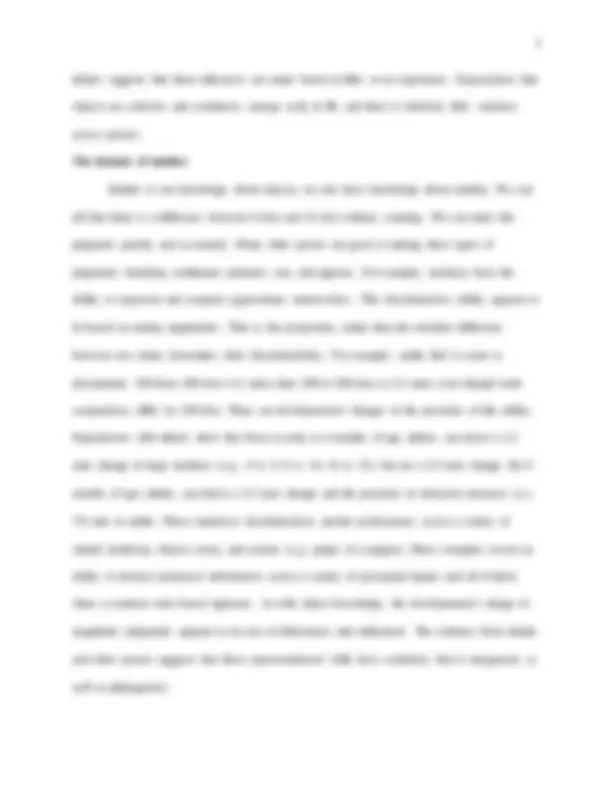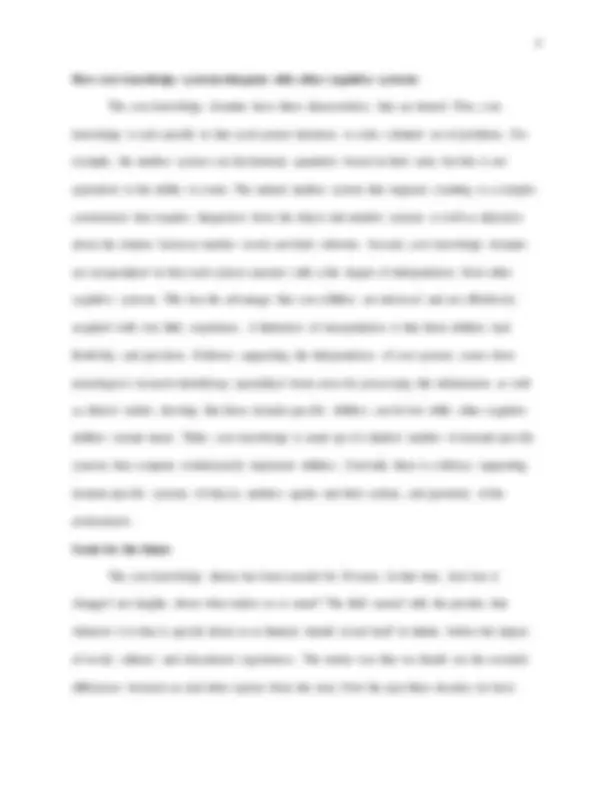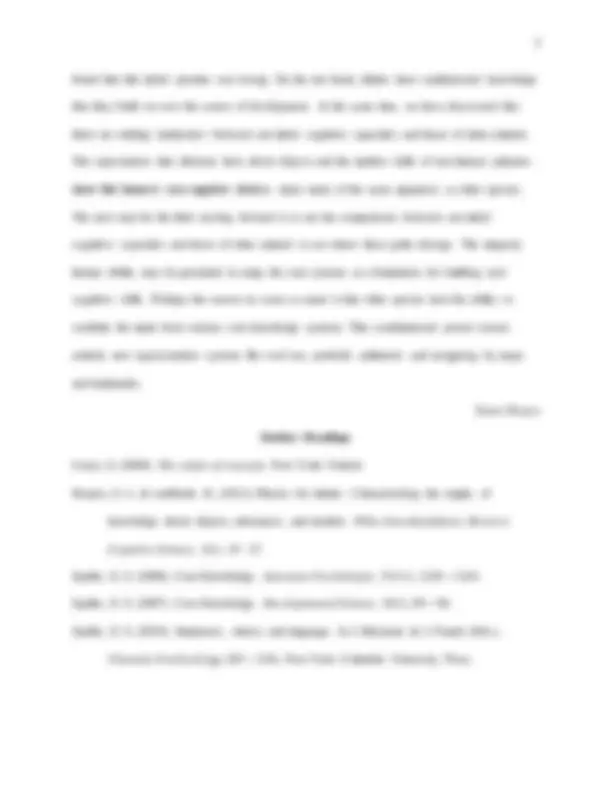





Study with the several resources on Docsity

Earn points by helping other students or get them with a premium plan


Prepare for your exams
Study with the several resources on Docsity

Earn points to download
Earn points by helping other students or get them with a premium plan
Community
Ask the community for help and clear up your study doubts
Discover the best universities in your country according to Docsity users
Free resources
Download our free guides on studying techniques, anxiety management strategies, and thesis advice from Docsity tutors
Core Knowledge is a psychological theory exploring the innate capacities present at birth and those acquired through experience. This approach focuses on the unique human capacities, comparing cognitive abilities across species to understand their origins. Two core knowledge domains are discussed: objects and number. Infants' expectations about objects' behavior and number discrimination reveal universal, ratio-based abilities with developmental refinements.
Typology: Lecture notes
1 / 5

This page cannot be seen from the preview
Don't miss anything!




Core Knowledge Core knowledge is a psychological theory that addresses age-old questions of what capacities are present from birth (therefore a product of evolution) and what capacities are acquired through experience. The central focus of this approach is whether our uniquely human capacities are evident early in development or whether the differences between our abilities and those of other species emerge later in development. To help us understand our uniquely human capacities, one goal of this theory is to compare our cognitive capacities to those of other species to see where these paths diverge. The key tenet of this approach is that underneath all the things that vary across humans, there exist a set of perceptual and conceptual capacities that are common to everyone. These core knowledge systems are innate mechanisms that do specific tasks. Some examples of core knowledge domains across species are: a songbird’s ability to learn a song characteristic of their species, an ant’s ability to navigate a terrain in search of food and then make a direct line back to the nest, and a human’s ability to acquire language. To illustrate the ideas behind core knowledge theory, this entry will describe two examples of core knowledge domains and the research that supports these ideas. We then return to the bigger question of how these findings lend new insight into what makes people so smart. The domain of objects Growing up we never receive explicit instruction about how objects behave and interact, yet we draw universally similar expectations. We all expect unsupported objects to fall down. We universally agree that hidden objects do not cease to exist when they are occluded from view. Such expectations appear to be universal across age groups as well as across individuals. Expectations about object knowledge are evident in other species as well. Rhesus macaques expect an object to stop when it comes in contact with a wall and not to pass through it. Humans
and chickens have similar expectations about partially occluded objects. These abilities may have a long phylogenetic history and are most likely the product of evolution. Experiments with infants show that from an early age infants parse the visual array into objects and events. As early as 2 months of age, infants expect objects to be permanent (e.g., they do not blink in and out of existence) and that two objects cannot occupy the same space at the same time (e.g., a ball cannot pass through a wall). Common to all humans, objects are perceived as bounded, solid, continuous entities. Yet object knowledge abilities are not fully mature at birth. Infants are active learners with powerful mechanisms of associative learning and memory abilities that become integrated with core knowledge systems. These initial core knowledge representations are primitive and leave many aspects of object knowledge undefined. What changes over the course of development is that, through experience interacting with the environment, infants learn which variables will let them predict the outcomes of events more precisely. For example, at 2 months of age infants already know that an object placed inside a container will move with the container when the container travels to a new location because objects do not pass through one another. However, infants have not identified detailed variables like how the height of an object determines how much of it will be hidden inside a container. Experiments with 5-month-old infants show that infants are not surprised if a very tall object is completely hidden in a short container. By 8 months of age though, infants have gained more experience manipulating objects in their environment and now expect that a tall object would only be partially occluded if lowered into a short container. These findings provide evidence that the change in object knowledge is one of elaboration and refinement. Taken together, these examples reveal that our knowledge about objects goes beyond the information available in the environment in ways that are universal. The evidence from young
How core knowledge systems integrate with other cognitive systems The core knowledge domains have three characteristics that are shared. First, core knowledge is task specific in that each system functions to solve a limited set of problems. For example, the number system can discriminate quantities based on their ratio, but this is not equivalent to the ability to count. The natural number system that supports counting is a complex construction that requires integration from the object and number systems as well as induction about the relation between number words and their referents. Second, core knowledge domains are encapsulated in that each system operates with a fair degree of independence from other cognitive systems. This has the advantage that core abilities are universal and are effortlessly acquired with very little experience. A limitation of encapsulation is that these abilities lack flexibility and precision. Evidence supporting the independence of core systems comes from neurological research identifying specialized brain areas for processing this information as well as clinical studies showing that these domain-specific abilities can be lost while other cognitive abilities remain intact. Third, core knowledge is made up of a limited number of domain-specific systems that comprise evolutionarily important abilities. Currently there is evidence supporting domain-specific systems of objects, number, agents and their actions, and geometry of the environment. Goals for the future The core knowledge theory has been around for 30 years. In that time, how has it changed our insights about what makes us so smart? The field started with the premise that whatever it is that is special about us as humans should reveal itself in infants before the impact of social, cultural, and educational experiences. The notion was that we should see the essential differences between us and other species from the start. Over the past three decades we have
found that this initial premise was wrong. On the one hand, infants have sophisticated knowledge that they build on over the course of development. At the same time, we have discovered that there are striking similarities between our initial cognitive capacities and those of other animals. The expectations that chickens have about objects and the number skills of non-human primates show that human’s core cognitive abilities share many of the same signatures as other species. The next step for the field moving forward is to use the comparisons between our initial cognitive capacities and those of other animals to see where these paths diverge. The uniquely human ability may be grounded in using the core systems as a foundation for building new cognitive skills. Perhaps the reason we seem so smart is that other species lack the ability to combine the input from various core knowledge systems. This combinatorial power creates entirely new representation systems like tool use, symbolic arithmetic and navigating by maps and landmarks. Susan Hespos Further Readings Carey, S. (2009). The origin of concepts. New York: Oxford. Hespos, S. J., & vanMarle, K. (2012). Physics for infants: Characterizing the origins of knowledge about objects, substances, and number. Wiley Interdisciplinary Reviews: Cognitive Science , 3 (1), 19 - 27. Spelke, E. S. (2000). Core Knowledge. American Psychologist, 55 (11), 1230 – 1243. Spelke, E. S. (2007). Core Knowledge. Developmental Science, 10 (1), 89 – 96. Spelke, E. S. (2010). Innateness, choice, and language. In J. Bricmont & J. Franck (Eds.), Chomsky Notebook (pp. 203 – 210). New York: Columbia University Press.